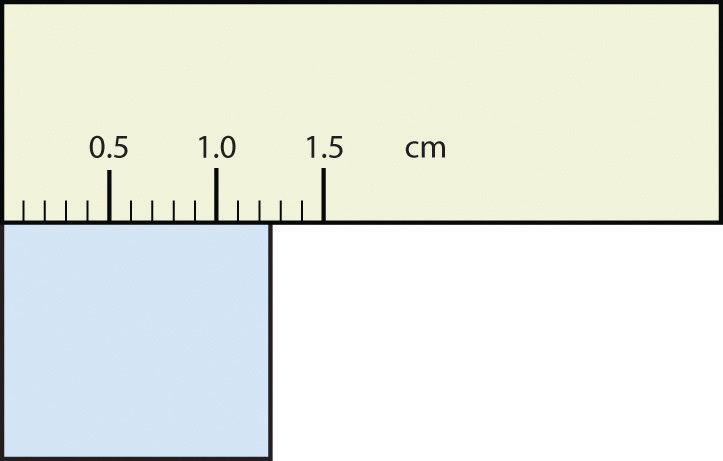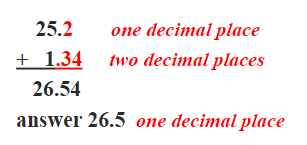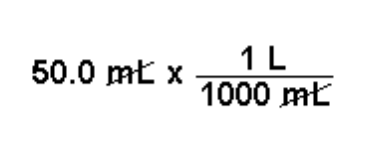
Measurements and Significant Figures
Measured Numbers
Measured Numbers: Numbers/Amounts that are determined using a measuring tool
(Examples includes: height or weight)
Significant Figures
Significant Figures: The “figures”, or digits that are important in measurements and calculations
(Simply speaking, it’s any digit that you measure plus one digit that you estimate.)
Example: The following image shows that it’s around 1.2 cm. It’s the last accurate digit in this picture. However, because they’re not perfect, we need to estimate a bit more past the last accurate digit. The following could range anywhere from 1.20-1.30… as long as it’s less than 1.30

What determines the number of significant figures in a Measurement?
The size of divisions on your measuring device
The size of the object
The difficulty in measuring the object
Which numbers are significant?
To begin, there are two types of numbers as far as significant figures are concerned: zeroes, and nonzero digits (1-9)
ALL nonzero digits are SIGNIFICANT !
Example: 1,234 has four significant figures
Some zeroes are significant, while others aren’t:
Leading zeroes
These are the zeroes in front of a number… they start it off. These zeroes NEVER count.
Example: 0.00001 has 1 significant figure (the 1)
Captive zeroes
These are the zeroes in between nonzero numbers. They ALWAYS count.
Example: 1.0091 has 5 significant figures (they all count)
Trailing zeroes
These are the zeroes at the end of a number. When a decimal point is in place, it counts… otherwise, they will not count.
Example: 1,000 has 1 significant figure (the 1), while 1,000.0 has 5 significant figures (all of them)
Exact Numbers
Exact numbers are numbers that are…
Obtained when you count objects
Obtained from a defined relationship
NOT obtained with measuring tools
Example: 12 eggs in a dozen
Exact numbers are known with absolute certainty, so they’re viewed as numbers with an infinite number of significant figures
(2 could be 2.0000000000000000…)
Operations with Significant Figures
Adding and Subtracting:
The answer has the same number of decimal places as the measurement with the fewest decimal places
Example:

Multiplying and Dividing:
Round the answer to the same number of significant figures as the measurement with the fewest significant figures
Example:

Scientific Notation
Scientific notations are used for very large numbers, or really small numbers
consists of a number between 1-10 followed by the power of 10
If the number you start with is greater than 1, the exponent will be positive
Example: 39923 = 3.9923 x 10^4
If the number you start with is less than 1, the exponent will be negative
Example: 0.0052 = 5.2 x 10^-3
Dimensional Analysis
Dimensional Analysis is a method that uses the idea that any number can be multiplied by one without changing its value
(Basically, it’s used to go from one unit to another)
Using conversion factors, you could set an equation up and multiply them to determine the new value in a new unit
You would have your starting value, and the conversion rate in a fraction next to it. The key to this method is to have the units cancel out, so that the value is left in the unit you want it in.
Example:

Oftentimes, this means that the unit you want to convert to is on the top, while the unit you’re trying to cancel out is on the bottom.
Basic Summary
Exact numbers are obtained by
Counting
Definition
Measured numbers are obtained by
Using a measuring tool
Significant figures are counted when
Nonzero numbers
Captive zeroes
Trailing zeroes WHEN there is a decimal point
Adding/Subtracting with Significant Figures: Round to number with fewest decimal places
Multiplying/Dividing with Significant Figures: Round to number with fewest significant numbers
When using scientific notation, make sure the first number is a number from 1-10 and the exponent is a power of 10
Measurements and Significant Figures
Measured Numbers
Measured Numbers: Numbers/Amounts that are determined using a measuring tool
(Examples includes: height or weight)
Significant Figures
Significant Figures: The “figures”, or digits that are important in measurements and calculations
(Simply speaking, it’s any digit that you measure plus one digit that you estimate.)
Example: The following image shows that it’s around 1.2 cm. It’s the last accurate digit in this picture. However, because they’re not perfect, we need to estimate a bit more past the last accurate digit. The following could range anywhere from 1.20-1.30… as long as it’s less than 1.30

What determines the number of significant figures in a Measurement?
The size of divisions on your measuring device
The size of the object
The difficulty in measuring the object
Which numbers are significant?
To begin, there are two types of numbers as far as significant figures are concerned: zeroes, and nonzero digits (1-9)
ALL nonzero digits are SIGNIFICANT !
Example: 1,234 has four significant figures
Some zeroes are significant, while others aren’t:
Leading zeroes
These are the zeroes in front of a number… they start it off. These zeroes NEVER count.
Example: 0.00001 has 1 significant figure (the 1)
Captive zeroes
These are the zeroes in between nonzero numbers. They ALWAYS count.
Example: 1.0091 has 5 significant figures (they all count)
Trailing zeroes
These are the zeroes at the end of a number. When a decimal point is in place, it counts… otherwise, they will not count.
Example: 1,000 has 1 significant figure (the 1), while 1,000.0 has 5 significant figures (all of them)
Exact Numbers
Exact numbers are numbers that are…
Obtained when you count objects
Obtained from a defined relationship
NOT obtained with measuring tools
Example: 12 eggs in a dozen
Exact numbers are known with absolute certainty, so they’re viewed as numbers with an infinite number of significant figures
(2 could be 2.0000000000000000…)
Operations with Significant Figures
Adding and Subtracting:
The answer has the same number of decimal places as the measurement with the fewest decimal places
Example:

Multiplying and Dividing:
Round the answer to the same number of significant figures as the measurement with the fewest significant figures
Example:

Scientific Notation
Scientific notations are used for very large numbers, or really small numbers
consists of a number between 1-10 followed by the power of 10
If the number you start with is greater than 1, the exponent will be positive
Example: 39923 = 3.9923 x 10^4
If the number you start with is less than 1, the exponent will be negative
Example: 0.0052 = 5.2 x 10^-3
Dimensional Analysis
Dimensional Analysis is a method that uses the idea that any number can be multiplied by one without changing its value
(Basically, it’s used to go from one unit to another)
Using conversion factors, you could set an equation up and multiply them to determine the new value in a new unit
You would have your starting value, and the conversion rate in a fraction next to it. The key to this method is to have the units cancel out, so that the value is left in the unit you want it in.
Example:

Oftentimes, this means that the unit you want to convert to is on the top, while the unit you’re trying to cancel out is on the bottom.
Basic Summary
Exact numbers are obtained by
Counting
Definition
Measured numbers are obtained by
Using a measuring tool
Significant figures are counted when
Nonzero numbers
Captive zeroes
Trailing zeroes WHEN there is a decimal point
Adding/Subtracting with Significant Figures: Round to number with fewest decimal places
Multiplying/Dividing with Significant Figures: Round to number with fewest significant numbers
When using scientific notation, make sure the first number is a number from 1-10 and the exponent is a power of 10
 Knowt
Knowt